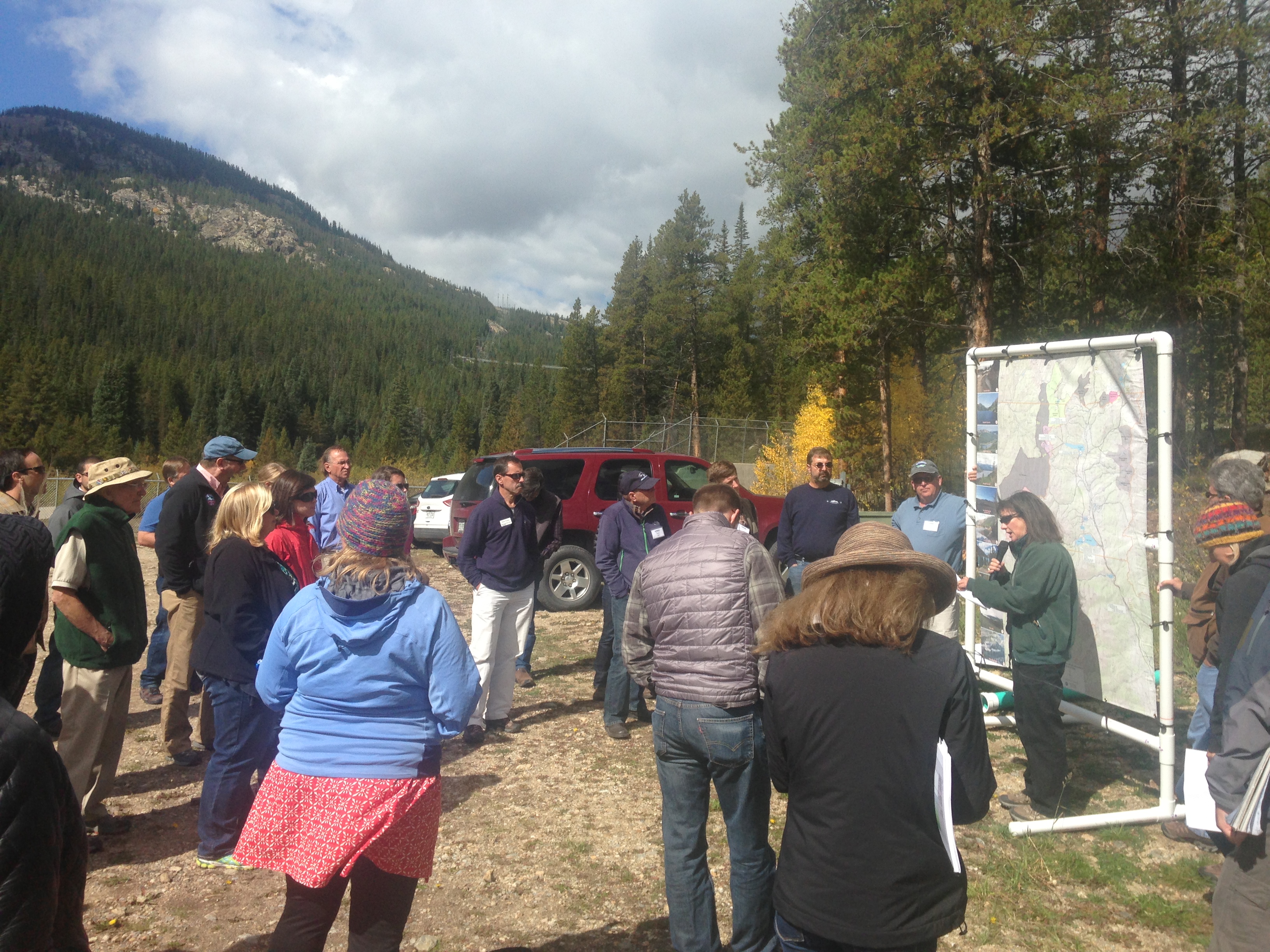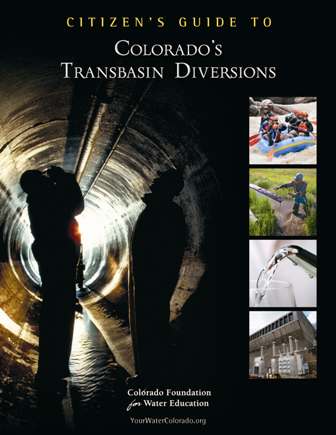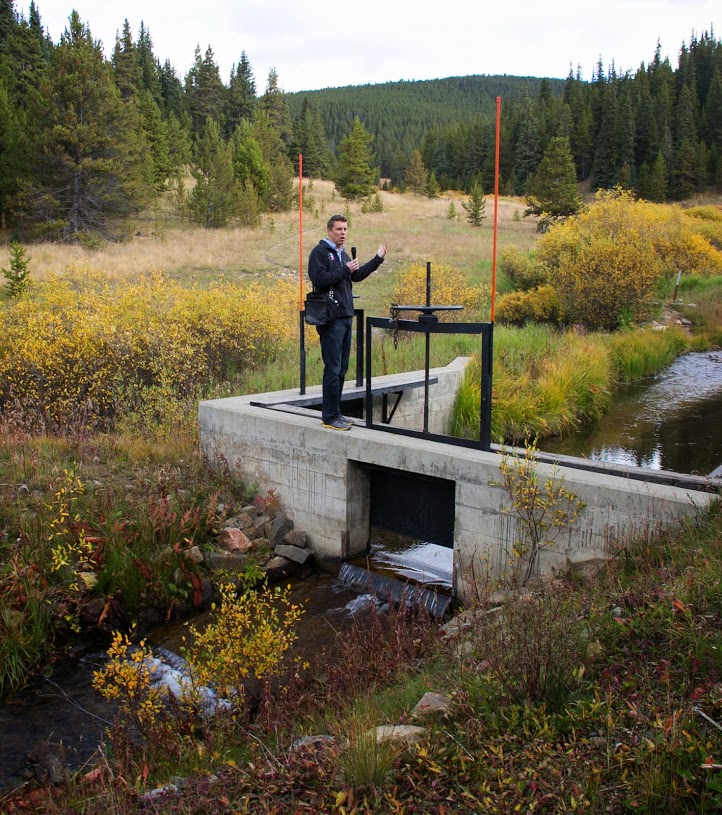“The interesting thing about all of these tunnels is you look through them and you can see a pinpoint of light at the end,” says Wayne Vanderschuere, the general manager for water and wastewater planning at Colorado Springs Utilities. Vanderschuere was talking about transbasin diversion tunnels.

Participants on the Colorado Foundation for Water Education’s transbasin diversion tour hear from Lynn Brooks with the Eagle River Water and Sanitation District beside the outlet of the Homestake Tunnel near Turquoise Reservoir.
The Colorado Foundation for Water Education returned from our transbasin diversion tour last week, exploring the Fryingpan-Arkansas, Twin Lakes, and Homestake projects with experts and a great group of about 30 tour participants from different organizations, interests and geographical locations. Find photos here. We heard about and saw the sights and workings of these important and major water diversion projects. Reporter, Dennis Webb with the Grand Junction Sentinel joined us and, in an article published this week, wrote:
Those interests met in the middle here last week, at this point where the Ewing Ditch crosses the Continental Divide, on a transbasin diversion tour presented by the Colorado Foundation for Water Education. It was a chance to consider the past of water development in Colorado while also pondering its future. And where better to look back at the history of transbasin diversions than at Ewing Ditch, the oldest diversion of Western Slope water to the Eastern Slope?
This straightforward, unassuming dirt conduit seemingly defies gravity, diverting water from Eagle River tributary Piney Gulch just a short walk from Tennessee Pass, and just high enough up the gulch that the water can follow a contoured course crossing basins and head into the Arkansas River Valley.
“It’s simple, but I love simplicity. It fits my mind,” Alan Ward, water resources manager with the Pueblo Board of Water Works, joked about the ditch, which the utility bought in 1955.
Buried in Snow
It was built in 1880 and also is called the Ewing Placer Ditch, which Ward believes suggests early use of the water in mining.
As transbasin diversions go, it’s a minuscule one, delivering up to 18.5 cubic feet per second, or an average of about 1,000 acre-feet in a year. It diverts about five square miles of melt-off from snowpack that can leave the ditch buried beneath 10 to 20 feet of snow in the winter. David Curtis is in charge of clearing that snow and maintaining and operating the ditch during the seven months out of each year that he works out of Leadville as a ditch rider for the utility.
The utility says Ewing Ditch is about three-quarters of a mile long.
“I think it’s a little longer,” Curtis said, adding that at least it seems that way when he and others are busy clearing spring snow.
A chartered bus delivered more than two dozen tour participants to view the ditch, including Boulder County resident Joe Stepanek. He found last week’s two-day tour to be highly informative. He’s interested in Colorado’s history of water development, and is retired from a U.S. Agency for International Development career that had him traveling abroad.
“I come back and join this water tour and learn a lot about Colorado,” he said.
Sonja Reiser, an engineer with CH2M HILL in Denver, likewise was finding the tour to be eye-opening.
“I’m learning so much about how complicated Colorado water law is,” she said as the tour bus moved on from this tiny diversion point to the outlet of the five-mile-long Homestake Tunnel, which goes under the Continental Divide from Homestake Reservoir in Eagle County and is capable of delivering a much more massive 800 cubic feet per second to help meet municipal needs in Colorado Springs and Aurora.

CFWE published the new Citizen’s Guide to Colorado’s Transbasin Diversions last month. flip through or order your copy.
Read another tour participant’s impressions and thoughts from the tour on the Northwest Colorado Council of Governments’ Water Quality and Quantity Blog.
For me, just being around the diversions was exciting. Only a month ago, CFWE released it’s newest publication, the Citizen’s Guide to Colorado’s Transbasin Diversions– I wrote much of it. After reading about these projects, pouring over maps trying to understand collection and distribution systems and working with the Division of Water Resources to determine how much water flows through these projects, I was seeing some of them, and hearing about them again.
The guide explores the history, negotiations and future of water supply planning in Colorado. It’s a lot of information condensed into 32 pages and drawn largely from other great resources including the three books and author perspectives found at the end of the guide. And it comes at an important time, as the draft of Colorado’s Water Plan collecting input and nearing completion, water supply and the history of water supply planning in Colorado are particularly relevant. But what didn’t make it in the guide, primarily because it is a reference guide and there was an abundance of other content, were the many great interviews I conducted with water managers, leaders, planners, advocates and others about projects all across the state. The tour brought life to the Citizen’s Guide, just like those interviews, as will our upcoming webinar series (more about that two paragraphs down).
These are such important stories, and interesting people who told them, so CFWE will be publishing excerpts from those interviews here on the blog. If you have a piece of the story that needs to be told, or wish we spoke with someone different, let us know– we welcome additional posts. Stay posted for a great series of interviews and additional transbasin diversion programming.
If you want to hear from experts yourself, register for one or all of our upcoming transbasin diversion webinars, hosted in partnership with Colorado Water Congress. The first of the series will be held on November 12 from 9-10 am on the Technical, Political and Environmental Requirements of Transbasin Diversions. Learn more and find out how to register here.


 Print
Print